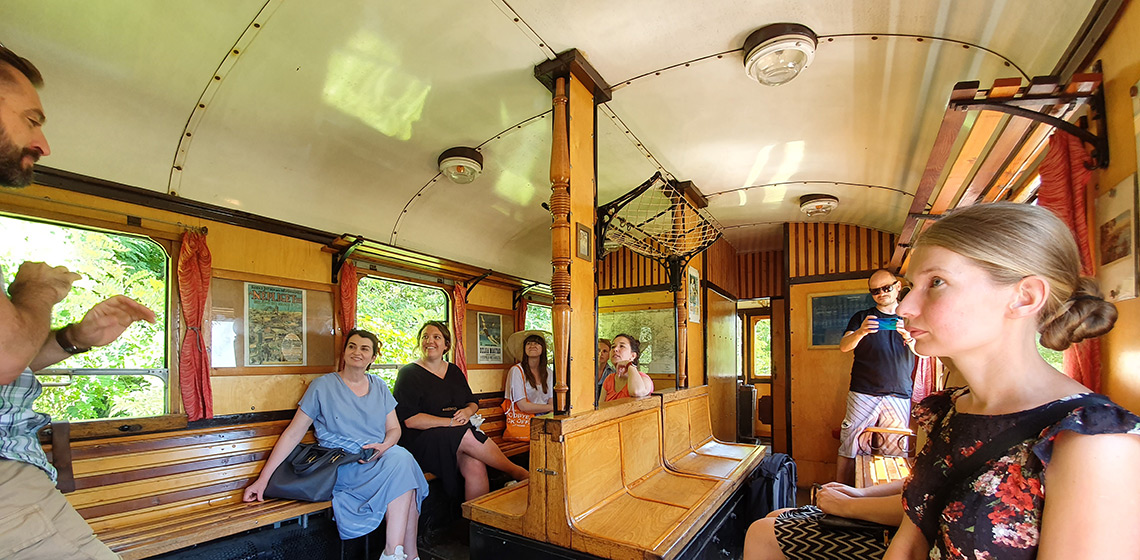The content is published under a Creative Commons Attribution Non-Commercial 4.0 License.
Unreviewed Mixed Matters Article:
Event Review: NEMO Learning Exchange in Budapest (HU)

The purpose of this Learning Exchange was to discover more about the Hungarian museum landscape, with examples of successful programmes engaging in social responsibility in Hungary. The host and organiser Zsolt Sari, Deputy Director General of the Hungarian Open Air Museum (Skanzen), was joined by colleagues from the Ludwig Museum, the Petofi Literary Museum, and the Herman Otto Museum. The programme promised a very successful combination of talks, workshops and museum visits over 2 days; it was facilitated by Meghan Corse of NEMO, with practical information for the six invited international museum professionals who attended: the Open Air Museum of Estonia/Estonian Museum Association (EE), the National Liberation Museum in Maribor (SI), the Open Air Museum of Lithuania (LT), the House of Leaves Museum in Tirana (AL), the Regional Museum of Skåne (S), the National Gallery in Dublin (IRL) and myself, representing EXARC.
The Solidary Museum: museum programmes taking social responsibility
Day 1: Ludwig Museum and Petofi Literary Museum, Budapest
27 June 2019
Introductions were followed by Balazs Meszaros, Managing Director of the Pulszky Society – the Hungarian Museum Association, who gave the group some context about the beginnings of this Museum Association, following the collapse of Soviet control.
Zsolt Sari presented his theory behind the ‘Solidary Museum’ from a museum leader’s perspective, emphasising the greater role within society that museums and museum leaders must play; not just by being more inclusive and facilitating the needs of their visitors, but also by addressing difficult social issues.
Rita Dabi-Farkas, museum educator at the Ludwig Museum and coordinator of the Museum Education and Methodology Centre (MOKK), gave a comprehensive presentation on ‘Chance with Museums’ the very useful handbook which she has edited for museum educators working with disadvantaged groups. This was followed by practical workshops highlighting staff training methods and examples of how to engage visitors with comprehension-related difficulties or visual impairment, and of how to integrate homeless visitors into museums without stigmatisation. One aspect we explored was engaging with visitors on the autistic spectrum using the museum’s collection of specially-designed clothing (designed by an autistic fashion designer) which, when worn, creates a sense of wellbeing and/or security and allows the wearer to then engage with their surroundings.
Anna Czekmany (Petofi Literary Museum) and Zsofia Mlakar (Herman Otto Museum) presented two different experimental museum education programmes, both part of ‘Invisible Dreams – Visible Spaces’; programmes designed to engage and enrich the lives of socially disadvantaged children and children of Roma heritage, using practical, hands-on activities (including archaeology) with good results.
Day 2: The Hungarian Open Air Museum (Skanzen, Szentendre, Hungary)
28 June 2019
The second day was entirely devoted to the Hungarian Open Air Museum, including a full tour of this enormous ethnographic open-air museum. Zsolt Sari presented the history of the museum and its ideas for visitor engagement (e.g. ecological thinking, storytelling, new specific time periods, dialogue with visitors, the processing of historical traumas). Marta Bokonics-Kramlik presented two of the large social responsibility programmes with some useful and thought-provoking workshops on the ‘Integrated Summer Programme’, an amazing programme which pairs special-needs children with teens completing their obligatory school community service, with positive personal and social results: bonding of the two groups, improving empathy and problem-solving intelligence, emotional enrichment, investment in quality time, being socially responsible, increasing their self-esteem and independence. The programme utilises the museum’s available collections, such as quern stones and wood-fired ovens, for activities like grinding wheat and making bread. Additional activities include churning butter, sawing wood, making adobe bricks and traditional handicrafts. We were able to see and follow the children in action on the day we visited, and we were all incredibly impressed with the interactions between the young people, facilitated by the museum’s natural setting and resources.
The second programme, ‘Museum in a Suitcase’, provides free educational outreach by museum staff to schools in remote and disadvantaged areas, which are represented at the museum with buildings and cultural references. Thus they reinforce the ties between those communities of cross-cultural heritage and the museum, and provide much-needed educational support.
Zsofia Szigethy presented a third programme, designed to help adults living with dementia recall their museum experiences (See PDF). It is an Erasmus+ joint programme with four Open Air Museums (Beamish, UK; Jamtli, SE; Maihaugen, NO; Aarhus, DK) and three universities. We were also able to participate in a brief workshop on the subject.
Overall, I was deeply impressed with every aspect of this Learning Exchange. The dedication of the museum staff to such creative and interesting programmes for social responsibility was truly inspirational. The organisation of the programme was perfect, and there was plenty of time built in for meaningful discussion, personal interaction and networking, with some great meals and sightseeing thrown in. Being part of the NEMO network has a number of benefits for EXARC, and I would actively encourage my fellow members to consider taking part in a training session or possibly even a workgroup.
Keywords
Country
- Hungary

